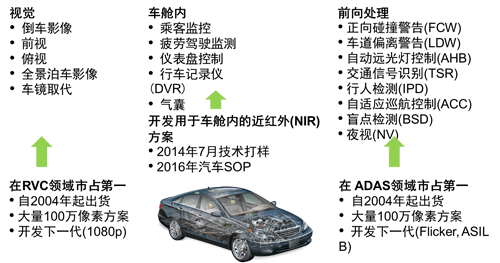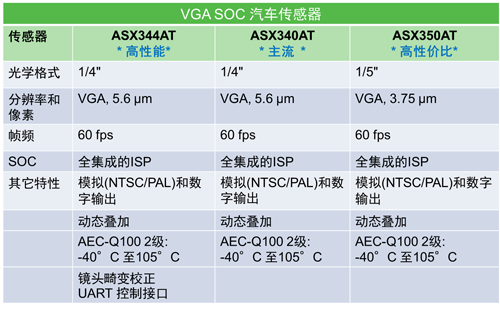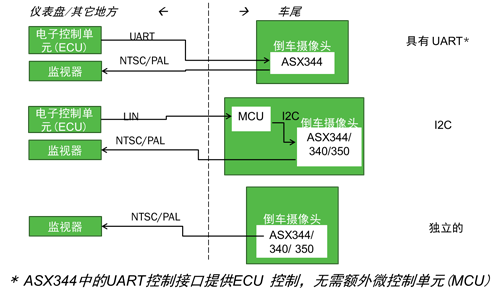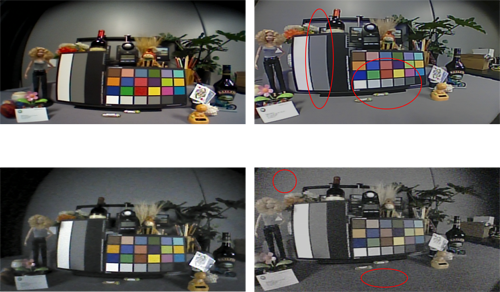- From June 2016 [ Smart Car Journal ] " Change The World " section
Learn more about the technology trends and reference designs of the Smart Car Journal .

In recent years, driven by the government's implementation and implementation of the Automotive Safety Act, consumer driving experience and the trend of automatic driving, the field of automotive image sensors has exploded. Automotive image sensing has a wide range of applications. Image sensors with superior performance and advanced image processing capabilities enhance driving safety while enhancing user driving experience, making it a hot technology in the automotive field in recent years. Forecasts show that the annual compound growth rate (CAGR) of revenue in the automotive CMOS sensor market will reach 28% between 2014 and 2018.
Main application fields of automotive image sensors
Automotive image sensors are used in a wide range of applications, including for vision applications such as reversing images, front view, rear view, overhead, panoramic parking images, and mirror replacement for cabin monitoring such as passenger monitoring, fatigue driving monitoring, and dashboard control. , driving recorder (DVR), airbag, for advanced driving assistance system (ADAS) such as forward collision warning, lane departure warning, automatic high beam control, traffic signal recognition, pedestrian detection, adaptive cruise control, blind spot detection, Night vision and more.
Key performance affecting imaging quality
The low light performance, dynamic range and image information processing capabilities are the key factors affecting the image quality.
1. Low light performance is a chip
The low-light performance is very important for automotive imaging systems, and its excellent low-light performance improves driving safety in low-light conditions such as at night. Image sensor manufacturers are targeting "can see in the dark."
2. High dynamic range (HDR)
HDR is another important feature of automotive imaging system applications, ensuring that the camera clearly presents scene details over a wide range of light, dark and high-light contrasts, improving the accuracy of image information for added security.
3. Wide Angle Fisheye Distortion Correction (DEWARP)
Wide-angle fisheye lens has the advantage of wide field of view for vehicle image, but the captured image information will produce a certain degree of distortion. DEWARP technology can be used to correct the video image distortion generated by wide-angle fisheye lens in real time, and the image will be restored. level.
4. Image overlay
Image superposition refers to the use of image sensor and image processing auxiliary chip to realize image extension, zoom, right view, two-plate left/right view, triple-line picture and reverse dynamic guide line. The image overlay function can better assist the driver to see the surrounding environment and reduce the accident rate.
ON Semiconductor's automotive image sensor solution
Since the launch of the world's first automotive CMOS image sensor in 2004, ON Semiconductor has more than 10 years of experience in providing specialized imaging solutions for the automotive industry. It has become the world's leading automotive imaging sensor, accounting for 46% of the entire automotive sensor market. %, the image sensor for ADAS has a market share of 70%, and is the market leader in the field of rearview imaging and ADAS. In terms of quality and performance, ON Semiconductor's automotive image sensor is fully compliant with AEC-Q100. It also offers superior low-light performance, high dynamic range for single-chip multiple exposure (HDR, >120 dB), and automotive-grade application optimization such as fisheye distortion correction and image overlay, and in 2015 launched the world's first support for ASIL ( Automotive Safety Integrity Level) Image Sensor. For some applications, ON Semiconductor also offers global shutter image sensors with superior performance, such as the Near Infrared (NIR) solution for cabin fatigue detection applications. In line with the market's move towards high-definition trends, ON Semiconductor has launched a large number of 1 million pixel solutions, and will develop more 1080p sensors in the future.

Figure 1: Automotive Image Sensor Applications and ON Semiconductor Market Position
The ASX344/340/350AT is a system-on-chip (SoC) for reversing images that integrates an image signal processor on a single chip. Enhanced pixel performance provides greater visibility in low light conditions, supporting up to 4 layers of image overlay Provides more reversing information to the display system, supports digital zoom and pan, and adds optical center point correction, which provides customers with lens center point correction after camera assembly and production, thus saving costs. All three image sensors are fully AEC-Q100 certified and have a wide operating temperature range of -40°C to 105°C. The difference is that the ASX344AT also integrates fisheye distortion correction and provides a UART control interface. Positioned as a "high performance" solution; the optical format of the ASX350AT is 1/5 inches, which is different from the 1/4 inch of the ASX344/340AT, positioned as a "cost effective" solution; and the ASX340AT is positioned as a "mainstream" solution. Designers can choose a targeted solution based on the specific needs of the target customer.

Table 1: ASX344/340/350AT Specifications

Table 2: ASX344/340/350AT Configuration Options
The ASX344AT's Fisheye Distortion Correction feature offers 180o wider scene coverage, and the sensor's dynamic range reflects the good DR-Pix pixel technology, making it a safer advantage than a fisheye-corrected lens, both day and night. As shown in Figure 1, the lens without the fisheye correction does not capture the image information of the Xiaohuangren, and after the fisheye correction, the driver can see the two little yellow guys behind the car from the monitor, thus avoiding the reverse Security risks.

Figure 2: ASX344AT Fisheye Distortion Correction Example (Left: Daytime; Right: Night)
The ASX34xAT series offers better color saturation than competing devices during the day (typically 100-200 lux bright light) and at night (typically the car reversing camera uses about 10 lux brake lights and reversing lights at night). And contrast, as shown in the red circle in Figure 2, under the illumination of 180 lux during the day, the images captured by the competing devices are over-sharpened and the color boundaries are gray-spotted; in the nighttime illuminating 9.5 lux illumination, competing devices The captured image is overly sharp and has more noise.
 ?
?
Figure 3: Imaging comparison between ASX34x and competing devices
When existing ADAS and vision applications are combined, ASIL will be the reference point for compliance and applicability of the new system. ASIL B-level compliance is the goal of current ADAS designers. ON Semiconductor introduced the world's first 2.3 megapixel CMOS image sensor AR0231AT that supports ASIL B. The device uses a breakthrough technology that reduces LED flicker (LFM), setting a new benchmark for ADAS applications. LFM technology eliminates high-frequency LED flicker from traffic lights and automotive LED lighting, allowing traffic signal reading algorithms to work in all lighting conditions. The AR0231AT features a 1/2.7-inch (6.82 mm) optical format and a 1928 (horizontal) x 1208 (vertical) active pixel array. It features the latest 3.0 micron back-illuminated (BSI) pixels (back-illuminated sensors typically provide higher sensitivity than front-illuminated sensors) and ON Semiconductor's DR-PixTM technology, providing dual conversion gain for all lighting conditions Improve performance. It captures images in linear, HDR or LFM mode and provides frame-to-frame context switching between modes. The AR0231AT offers up to 4 exposures of HDR, capturing over 120 dB of dynamic range with excellent noise performance, enabling simultaneous support of multiple cameras for easy implementation of multiple sensor nodes in automotive applications, and through a simple two-line string The line interface implements user programmability. It also has multiple data interfaces including MIPI (Mobile Industry Processor Interface), Parallel and HiSPi (High Speed ​​Serial Pixel Interface). Other key features include optional automation or user-controlled black level control, support for spread-spectrum clock input, and multi-color filter array selection.
For challenging applications such as driver monitoring, ON Semiconductor introduced the industry's first global shutter sensor AR0135AT, which is 10 times lower than the previous generation and 4 times faster.
In addition, ON Semiconductor also offers advanced image coprocessors for total system solutions such as the AP0200AT image coprocessor optimized for rearview cameras and Ethernet output, integrated spatial conversion engine supporting lens distortion correction and fisheye correction (STE), and sophisticated overlay graphics engine; AP0201AT image coprocessor also provides Ethernet output for Ethernet-based panoramic reversing camera; AP0202AT image coprocessor for digital panoramic reversing camera with 24-bit parallel output; AP0102AT image The coprocessor is for 1 megapixel 720p rearview video with STE and overlay graphics engine. These coprocessors provide functional safety features in accordance with the Automotive Safety Integrity Level (ASIL) Class A and Class B. The AP020x series can be used in conjunction with existing image sensors such as the 1 million-pixel AR0140AT, AR0132AT and AR0136AT and the new 2 megapixel 1080p sensor AR0230AT.
Conclusion
The installation of the camera can eliminate the blind spot of the traditional mirror and reduce the traffic accident rate. It is also the basis of the rapidly developing vehicle network. It will be gradually promoted and applied in practice, and even become the standard of the car. The image sensor is the hero behind it. ON Semiconductor is the global leader in automotive image sensors. Its product and solution lineup spans every segment, including vision and ADAS applications, providing high dynamic range, excellent low light sensitivity, and superior performance over a wide temperature range. Emerging areas such as in-cabin inspection provide excellent performance of the global shutter solution, fully comply with AEC-Q100, and in line with market trends and customer needs, continue to promote new product development, to higher resolution, add more interfaces and conform to ASIL .
Cassava Dregs Separator,Cassava Processing Machine,Cassava Processing Equipment,Cassava Milling Machine
Hunan Furui Mechanical and Electrical Equipment Manufacturing Co., Ltd. , https://www.thresher.nl
